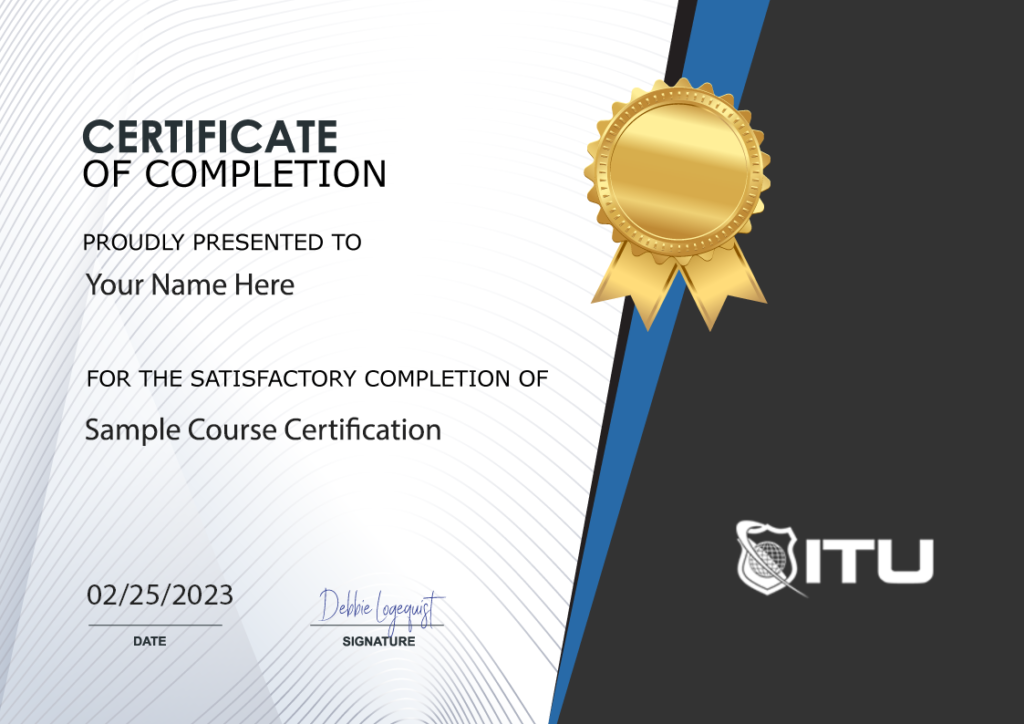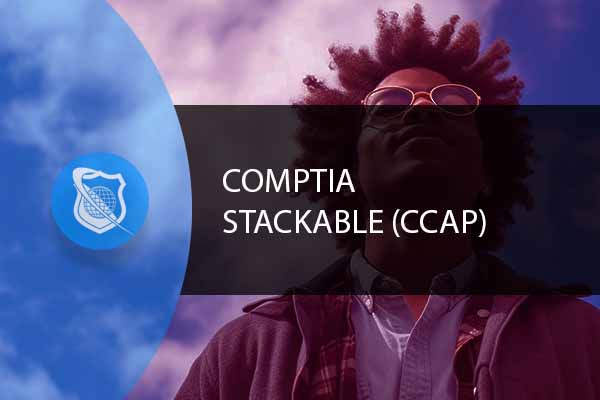CompTIA Cloud Admin Professional (CCAP)
IT professionals with 2-5 years of experience can gain the valuable CompTIA CCAP certification by following their Certification Path. This comprehensive study guide will provide you with all the essential learning materials and advice needed to ace both your CompTIA Network+ and Cloud+ exams, giving you a competitive edge in today’s ever-evolving tech industry.
Included In This Course



Closed Captions



Certificate of Completion
What is the CompTIA CCAP?
The CompTIA CCAP is a stackable certification by CompTIA. It is designed for IT professionals with 2 to 5 years of experience. The ITU Certification Path for the CompTIA CCAP certification consists of the learning materials to allow you to study for and pass the CompTIA Network+ and CompTIA Cloud+ exams. The two courses contained in this path are:
CompTIA Network+ encompasses the setup, regulation, and diagnosing of regular wired and wireless network platforms. It is designed to hone in on crucial security approaches, cloud computing protocols and service forms, up-to-date hardware components as well as virtualization systems for professionals who wish to fine tune their networks’ resilience.
Topics reviewed
- networks against threats
- wireless network solutions
- analytics to networks
- knowledge of networking concepts
CompTIA Cloud+ If you’re looking to ensure your business is secure, reliable and efficient by leveraging cloud computing solutions, the CompTIA Cloud+ certification proves that you have the know-how necessary to deploy and automate a strong cloud environment.
Topics reviewed
- cloud networking concepts
- cloud principles
- cloud technologies
- cloud Security
- cloud environment
- cloud Architects
Upon successfully passing the applicable exams provided by CompTIA, you will earn the CCAP certification badge.
For more information on CompTIA Stackable Certifications, visit the CompTIA website. Pricing charged by CompTIA varies by exam. For details on current pricing, visit CompTIA Pricing on their website.
Frequently Asked Questions About CompTIA Cloud Admin Professional (CCAP)
What is the CompTIA CCAP course?
The CompTIA Cloud Admin Professional (CCAP) course is a comprehensive study guide that provides essential learning materials and advice to help you pass the CompTIA Network+ and Cloud+ exams. It’s designed for IT professionals with 2-5 years of experience, aiming to give them a competitive edge in the tech industry.
What does the course include?
The course includes 60 hours of training, 340 videos, 34 topics, and 279 practice questions. It covers the necessary materials to study for and pass the CompTIA Network+ and Cloud+ exams.
Who are the instructors for this course?
The course is instructed by Dawn Briggs, an IT professional with more than 20 years of experience, and Chrys Thorsen, an education and technology expert who specializes in enterprise-level IT infrastructure consulting and certified training-of-trainers.
What skills will I gain from the CompTIA CCAP certification?
Upon completion of the course and passing the exams, you’ll acquire skills in business continuity, cloud networking, cloud security, network management, network security, network troubleshooting, orchestration, routing and switching, service level agreements (SLAs), software-defined networking, virtualization, and virtual networks.
How do I earn the CompTIA CCAP certification?
To earn the CompTIA CCAP certification, you need to pass the CompTIA Network+ and Cloud+ exams. After successfully passing the exams, you will earn the CCAP certification badge.
How can I access this course?
You can access this course and over 2,500 hours of on-demand content with the All Access Monthly Subscription. You get a 7-day free trial, and you can cancel anytime.
Proudly DisplayYour Achievement
Upon completion of your training, you’ll receive a personalized certificate of completion to help validate to others your new skills.
CompTIA Network+ N10-008 Course Content
Module 0 - Course introduction
- 0.1 Instructor Intro
- 0.2 Course Overview
Module 1 - Networking Fundamentals
- 1.1 Intro to Networking
- 1.1.1 Activity: Creating a Network
- 1.2 Common Terminology
- 1.2.1 Activity: Examining Ports and Sockets
- 1.3 OSI Model
- 1.4 DoD Model
- 1.4.1 Activity: Examining Network Layers
- 1.5 TCP, UDP, IP
- 1.5.1 Activity: Examining TCP
- 1.5.2 Activity: Examining UDP
- 1.5.3 Activity: Examining IP
- 1.6 ICMP, IGMP, ARP
- 1.6.1 Activity: Examining ICMP
- 1.6.2 Activity: Examining ARP
- 1.6.3 Activity: Examining IGMP
- 1.7 Network Topologies
- 1.8 Network Types
- 1.9 Part 1: Network Characteristics
- 1.9 Part 2: Network Characteristics
- 1.10 Module 1 outro
Module 2 - Cables and Connectors
- 2.1 Ethernet Standards
- 2.2 Copper Cable Types
- 2.3 Fiber Optic Cable Types
- 2.4 Connector Types
- 2.4.1 Activity: Selecting the Right Cable
- 2.5 Media Converters and Transceivers
- 2.6 Cable Management
- 2.7 Module 2 Outro
Module 3 - Internet Protocol (IP)
- 3.1 IPv4 Basics
- 3.2 IP Packet and Interface Types
- 3.2.1 Activity: Configuring Client IP Settings
- 3.3 Binary Numbering System
- 3.4 Classful and Classless Addressing
- 3.5 Understanding CIDR Notation
- 3.6 IPv4 Subnetting Method
- 3.7 Verifying with Binary
- 3.8 Finding Subnet IDs
- 3.8.1 Activity: Subnetting a Class C Network
- 3.9 The Delta in Action
- 3.9.1 Activity: Subnetting With the Delta
- 3.10 Subnetting Based on Hosts
- 3.11 Subnetting in Other Octets
- 3.12 Supernetting
- 3.12.1 Activity: Supernetting
- 3.13 IPv6
- 3.14 IPv4 - IPv6 Transition Mechanisms
- 3.15 Module 3 Outro
Module 4 - Layer 7 Protocols
- 4.1 Remote Control Protocols
- 4.2 File Sharing Protocols
- 4.3 Web Protcols
- 4.4 Email Protocols
- 4.5 Database Protocols
- 4.6 Voice Protocols
- 4.7 Security Protocols
- 4.8 Management Protocols
- 4.9 Module 4 Outro
Module 5 - Network Services
- 5.1 DHCP
- 5.1.1 Activity: Configuring DHCP
- 5.1.2 Activity: Configuring a DHCP Relay Agent
- 5.2 DNS
- 5.2.1 Activity: Configuring DNS - Part 1
- 5.2.2 Activity: Configuring DNS - Part 2
- 5.3 NTP
- 5.4 Corporate and Datacenter Network Architecture
- 5.5 Cloud Concepts and Connectivity Options
- 5.6 Module 5 Outro
Module 6 - Networking Devices
- 6.1 Introductory Concepts
- 6.2 Repeaters and Hubs
- 6.2.1 Activity: Connecting Devices with a Hub
- 6.3 Bridges and Switches
- 6.3.1 Activity: Connecting Devices with a Switch
- 6.4 Routers and Multilayer Switches
- 6.5 Security Devices
- 6.6 Modems
- 6.7 Module 6 Outro
Module 7 - Networked Devices
- 7.1 IP Devices
- 7.2 IoT
- 7.2.1 Activity - Programming IoT Devices
- 7.3 ICS/SCADA
- 7.4 Module 7 Outro
Module 8 - Routing and Bandwidth Management
- 8.1 Routing Basics
- 8.1.1 Activity: Configuring Static Routes
- 8.2 Packet Delivery on the Same Network
- 8.3 IP Routing Across a Single Router
- 8.4 IP Routing Across Multiple Hops
- 8.4.1 Activity: Static Routes - CHALLENGE
- 8.5 Route Selection
- 8.6 RIP
- 8.6.1 Activity: Configuring RIP - CHALLENGE
- 8.7 OSPF
- 8.8 EIGRP
- 8.9 BGP
- 8.10 NAT/PAT
- 8.11 Bandwidth Management (with Module 8 Outro)
Module 9 - Ethernet Switching
- 9.1 Ethernet Basics
- 9.2 Switching Overview
- 9.2.1 Activity: Examining a MAC Table
- 9.3 VLANs
- 9.3.1 Activity: Creating VLANs
- 9.4 VLAN Trunking
- 9.4.1 Activity: Configuring VLAN Trunking
- 9.5 VLAN Routing
- 9.5.1 Activity: Configuring VLAN Routing
- 9.6 Contention Management
- 9.7 Switchport Configuration (with Module 9 Outro)
Module 10 - Wireless Technologies
- 10.1 Wireless Overview
- 10.2 Radio Basics
- 10.3 Modulation
- 10.4 Wi-Fi Standards
- 10.5 Antennas
- 10.6 Wi-Fi Service Sets
- 10.7 Wi-Fi Security
- 10.8 Cellular
Module 11 Network Performance
- 11.1 Monitoring Performance
- 11.2 Common Metrics
- 11.2.1 Activity: Examining Interface Statistics
- 11.3 SNMP
- 11.4 Netflow
- 11.5 Network Security Monitoring (with Module 11 Outro)
Module 12 High Availability and Disaster Recovery
- 12.1 HA and DR Concepts
- 12.2 High Availability Mechanisms
- 12.3 Disaster Recovery Mechanisms
- 12.4 Facility and Infrastructure Support (with Module 12 Outro)
Module 13 Organizational Documents
- 13.1 Plans and Procedures
- 13.2 Security Policies
- 13.3 Loss Prevention
- 13.4 Common Agreements
- 13.5 Common Documentation
- 13.6 Structured Cabling - MDF and IDF
- 13.7 Horizontal and Vertical Cabling
- 13.7.1 Activity - Implementing Cable Management
- 13.8 Labeling
- 13.9 Surveys and Assessments (with Module 13 Outro)
Module 14 Network Security
- 14.1 Common Security Concepts
- 14.2 Common Attack Types
- 14.3 Spoofing-based Attacks
- 14.4 Hijacking and MITM
- 14.5 Social Engineering
- 14.6 Network Segmentation
- 14.7 Private VLANs
- 14.8 Single Organization Authentication
- 14.9 Extending Authentication
- 14.10 Authorization
- 14.11 Network Device Hardening
- 14.12 Wireless Security
- 14.13 Remote Access Security
- 14.14 IoT Security
- 14.15 Physical Security (with Module 14 Outro)
Module 15 Network Troubleshooting
- 15.1 Troubleshooting Methodology
- 15.2 Physical Connectivity Issues
- 15.3 Hardware Testing Tools
- 15.3.1 Activity - Testing an Ethernet Cable
- 15.3.2 Activity - Crimping on an RJ-45 Connector
- 15.3.3 Activity - Punching Down Twisted Pair
- 15.3.4 Activity - Using a Telephone Toner
- 15.4 Understanding Electricity
- 15.4.1 Activity - Checking Cable Continuity
- 15.4.2 Activity - Testing DC Voltage
- 15.4.3 Activity - Testing AC Voltage
- 15.5 Twisted Pair Pinout Problems
- 15.6 Twisted Pair Termination Problems
- 15.7 Repairing Damaged Twisted Pair Cable
- 15.8 Fiber Optic Connectivity Issues
- 15.8.1 Activity - Testing a Fiber Optic Cable
- 15.9 Common Port Problems
- 15.9.1 Working with Ports and Their Devices
- 15.10 Common Software Testing Tools
- 15.10.1 Activity - Scanning for Open Ports
- 15.11 Common Command Line Utilities
- 15.12 Troubleshooting Basic IP Networking Issues
- 15.13 Common Switching Issues
- 15.14 Switching Test Tools and Techniques
- 15.15 Common IP Routing Issues
- 15.16 Wi-Fi Access Point Issues
- 15.17 Wirelss Interference
- 15.17.1 Activity - Using a Spectrum Analyzer
- 15.18 Wireless Antenna Issues
- 15.18.1 Activity - Configuring a Wi-Fi Router
- 15.19 WAP Placement Strategies
- 15.20 Infrastructure Service Issues (DHCP)
- 15.21 Infrastructure Service Issues (DNS)
- 15.22 Infrastructure Service Issues (NTP)
- 15.23 Fireall / ACL Issues
- 15.24 VPN Issues
- 15.25 Additional Network Security Troubleshooting and Tips
- 15.26 Advanced Networking Issues
- 15.27 Troubleshooting Server Services (with Module 15 Outro)
- CompTIA Network+ N10-008 Course Outro
CompTIA Cloud+ (CVO-002) Course Content
Module 1: Preparing to Deploy Cloud Solutions
- Course Introduction
- Instructor Intro
- Describe Interaction of Cloud Components and Services
- Activity Scenario Introduction
- Describe Interaction of Cloud Components and Services Activity
- Describe Interaction of Non-cloud Components and Services
- Describe Interaction of Non-cloud Components and Services Activity
- Evaluate Existing Components and Services for Cloud Deployment
- Evaluate Existing Components and Services for Cloud Deployment Activity
- Evaluate Automation and Orchestration Options
- Evaluate Automation and Orchestration Options Activity
- Prepare for Cloud Deployment
- Prepare for Cloud Deployment Activity
Module 2: Deploying a Pilot Project
- Manage Change in a Pilot Project
- Manage Change in a Pilot Project Activity
- Execute Cloud Deployment Workflow
- Execute Cloud Deployment Workflow Activity
- Complete Post-Deployment Configuration
- Complete Post-Deployment Configuration Activity
Module 3: Testing Pilot Project Deployments
- Identify Cloud Service Components for Testing
- Identify Cloud Service Components for Testing Activity
- Test for High Availability and Accessibility
- Test for High Availability and Accessibility Activity
- Perform Deployment Load Testing
- Perform Deployment Load Testing Activity
- Analyze Test Results
- Analyze Test Results Activity
Module 4: Designing a Secure and Compliant Cloud Infrastructure
- Design Cloud Infrastructure for Security
- Design Cloud Infrastructure for Security Activity
- Determine Organizational Compliance Needs
- Determine Organizational Compliance Needs Activity
Module 5: Designing and Implementing a Secure Cloud Environment
- Design Virtual Network for Cloud Deployment
- Design Virtual Network for Cloud Deployment Activity
- Determine Network Access Requirements
- Determine Network Access Requirements Activity
- Secure Networks for Cloud Interaction
- Secure Networks for Cloud Interaction Activity
- Manage Cloud Component Security
- Implement Security Technologies
- Implement Security Technologies Activity
Module 6: Planning Identity and Access Management for Cloud Deployments
- Determine Identity Management and Authentication Technologies
- Determine Identity Management and Authentication Technologies Activity
- Plan Account Management Policies for the Network and Systems
- Plan Account Management Policies for the Network and Systems Activity
- Control Access to Cloud Objects
- Control Access to Cloud Objects Activity
- Provision Accounts
- Provision Accounts Activity
Module 7: Determing CPU and Memory Sizing for Cloud Deployments
- Determine CPU Size for Cloud Deployment
- Determine CPU Size for Cloud Deployment Activity
- Determine Memory Size for Cloud Deployment
Module 8: Determing Storage Requirements for Cloud Deployments
- Determine Storage Technology Requirements
- Determine Storage Technology Requirements Activity
- Select Storage Options for Deployment
- Select Storage Options for Deployment Activity
- Determine Storage Access and Provisioning Requirements
- Determine Storage Access and Provisioning Requirements Activity
- Determine Storage Security Options
- Determine Storage Security Options Activity
Module 9: Analyzing Workload Characteristics to Ensure Successful Migration
- Determine the Type of Cloud Deployment to Perform
- Determine the Type of Cloud Deployment to Perform Activity
- Manage Virtual Machine and Container Migration
- Manage Virtual Machine and Container Migration Activity
- Manage Network, Storage, and Data Migration
- Manage Network, Storage, and Data Migration Activity
Module 10: Maintaining Cloud Systems
- Patch Cloud Systems
- Patch Cloud Systems Activity
- Design and Implement Automation and Orchestration for Maintenance
- Design and Implement Automation and Orchestration for Maintenance Activity
Module 11: Implementing Backup, Restore, Disaster Recovery, and Business Continuity Measures
- Back Up and Restore Cloud Data
- Back Up and Restore Cloud Data Activity
- Implement Disaster Recovery Plans
- Implement Disaster Recovery Plans Activity
- Implement Business Continuity Plans
- Implement Business Continuity Plans Activity
Module 12: Analyzing Cloud Systems for Performance
- Monitor Cloud Systems to Measure Performance
- Monitor Cloud Systems to Measure Performance Activity
- Optimize Cloud Systems to Meet Performance Criteria
- Optimize Cloud Systems to Meet Performance Criteria Activity
Module 13: Analyzing Cloud Systems for Anomalies and Growth Forecasting
- Monitor for Anomalies and Resource Needs
- Monitor for Anomalies and Resource Needs Activity
- Plan for Capacity
- Plan for Capacity Activity
- Create Reports on Cloud System Metrics
- Create Reports on Cloud System Metrics Activity
Module 14: Troubleshooting Deployment, Capacity, Automation, and Orchestration Issues
- Troubleshoot Deployment Issues
- Troubleshoot Deployment Issues Activity
- Troubleshoot Capacity Issues
- Troubleshoot Capacity Issues Activity
- Troubleshoot Automation and Orchestration Issues
- Troubleshoot Automation and Orchestration Issues Activity
Module 15: Troubleshooting Connectivity Issues
- Identify Connectivity Issues
- Identify Connectivity Issues Activity
- Troubleshoot Connectivity Issues
- Troubleshoot Connectivity Issues Activity
Module 16: Troubleshooting Security Issues
- Troubleshoot Identity and Access Issues
- Troubleshoot Identity and Access Issues Activity
- Troubleshoot Attacks
- Troubleshoot Attacks Activity
- Troubleshoot Other Security Issues
- Troubleshoot Other Security Issues Activity
Module 17: Exam Information, Review, and Summary
- Exam Information
- Course Review
Module 18: Activities
- Activity Scenario Introduction
- Describe Interaction of Cloud Components and Services Activity
- Describe Interaction of Non-cloud Components and Services Activity
- Evaluate Existing Components and Services for Cloud Deployment Activity
- Evaluate Automation and Orchestration Options Activity
- Prepare for Cloud Deployment Activity
- Manage Change in a Pilot Project Activity
- Execute Cloud Deployment Workflow Activity
- Complete Post-Deployment Configuration Activity
- Identify Cloud Service Components for Testing Activity
- Test for High Availability and Accessibility Activity
- Perform Deployment Load Testing Activity
- Analyze Test Results Activity
- Design Cloud Infrastructure for Security Activity
- Determine Organizational Compliance Needs Activity
- Design Virtual Network for Cloud Deployment Activity
- Determine Network Access Requirements Activity
- Secure Networks for Cloud Interaction Activity
- Implement Security Technologies Activity
- Determine Identity Management and Authentication Technologies Activity
- Plan Account Management Policies for the Network and Systems Activity
- Control Access to Cloud Objects Activity
- Provision Accounts Activity
- Determine CPU Size for Cloud Deployment Activity
- Determine Storage Technology Requirements Activity
- Select Storage Options for Deployment Activity
- Determine Storage Access and Provisioning Requirements Activity
- Determine Storage Security Options Activity
- Determine the Type of Cloud Deployment to Perform Activity
- Manage Virtual Machine and Container Migration Activity
- Manage Network, Storage, and Data Migration Activity
- Patch Cloud Systems Activity
- Design and Implement Automation and Orchestration for Maintenance Activity
- Back Up and Restore Cloud Data Activity
- Implement Disaster Recovery Plans Activity
- Implement Business Continuity Plans Activity
- Monitor Cloud Systems to Measure Performance Activity
- Optimize Cloud Systems to Meet Performance Criteria Activity
- Monitor for Anomalies and Resource Needs Activity
- Plan for Capacity Activity
- Create Reports on Cloud System Metrics Activity
- Troubleshoot Deployment Issues Activity
- Troubleshoot Capacity Issues Activity
- Troubleshoot Automation and Orchestration Issues Activity
- Identify Connectivity Issues Activity
- Troubleshoot Connectivity Issues Activity
- Troubleshoot Identity and Access Issues Activity
- Troubleshoot Attacks Activity
- Troubleshoot Other Security Issues Activity
| 5 star | 82 | 82% |
| 4 star | 17 | 17% |
| 3 star | 1 | 1% |
| 2 star | 0% | |
| 1 star | 0% |
Sorry, no reviews match your current selections
Your Training Instructors
Dawn Briggs is an information technology professional with more than 20 years of experience in directing IT departments, leading technical implementations, managing personnel, ensuring the security of information, and establishing high customer service standards. Although she has a broad range of experience across the IT industry that includes everything from pc repair to database management, her career has primarily focused on training technical personnel to plan, implement, and maintain IT infrastructure and web-based technologies. Dawn has been instructing students in IT courses, and mentoring students in skills that allow them to obtain jobs in information technology career fields, for over seven years.
Chrys Thorsen is an education and technology expert who specializes in enterprise-level IT infrastructure consulting and certified training-of-trainers. In her career, she has garnered over 50 IT Certifications including CISSP, CISA, CEHv12, PenTest+, CompTIA CNVP, Cisco CCSI/CCNP, Microsoft Cloud and on-premises technologies, VMware vSphere, and many more. She has also authored 40 published certification textbooks, and over 35 full-length IT certification video courses.
When not working in the United States, Chrys spends her time abroad capacity-building IT literacy in developing nations in Sub-Saharan Africa. Her client list has included: the US Federal Government, the Republic of Zambia Ministry of Health, Cavendish University Zambia, Accenture, JP Morgan Chase, the US Centers for Disease Control and Prevention, the Elizabeth Glaser Pediatric AIDS Foundation (EGPAF), Hughes Aircraft, Microsoft, and many more.
Chrys lives by, and is fond of repeating, her professional creed:
“The only true measure of success for any project or training is results on the ground. Everything else is just noise.” “I teach what I deploy; I deploy what I teach.”

Subscribe To All-Access
Lock In $16.99 / Month Forever
Access this course and over 2,900 hours of focused IT training. Start your first month for only $1.00. Then lock in only $16.99 / month for life.
- Get Every Course
- Free Updates / New Content Added
- 2,900+ Hours of IT Training
- Price Lock Guarantee
- Games / Flashcards
- 22,000+ Practice Questions
- AI Study Buddy
- Certificates of Completion
$49.99 $16.99 Monthly
$59.00






good
Smooth delivery and easy access to LMS. Good to see that the LMS offers progress tracking. Would be great if badges were offered on completion of courses to share via Credly to future employers.